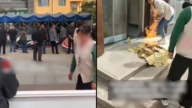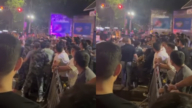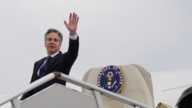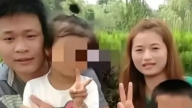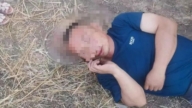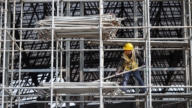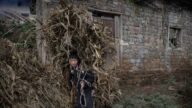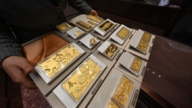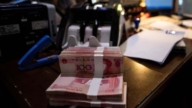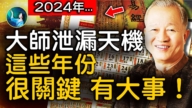【新唐人2011年8月22日讯】北京故宫博物院一波未平,一波又起,相关负责人承认,有100多册图书不知下落,目前“挂账存疑”。大陆媒体和民众因此拿台北故宫来比较,不比不知道,一比之下,人们不禁感叹:同样是故宫,怎么就那麽不同?
一名自称“故宫职工”者向大陆媒体反映,故宫图书馆善本书库部分图书丢失,上报副院长陈丽华后,事情被压下不让追查。故宫博物院相关负责人表示,目前确实有100多册图书“挂账存疑”有待详查,包括部分普通古籍,也有一般线装书和印刷品。这名负责人解释说,因为故宫图书馆的普通古籍在历史上一直没有纳入文物管理范畴,从2004年开始的全面文物大清理才重新逐步核对。
北京故宫从今年5月起频频传出事故和丑闻,包括文物轻易被盗、锦旗写白字、建福宫变成私人会所、私下拍卖故宫文物、宋代哥窑瓷器被毁、清代屏风浸水、“文革”期间3000套清代御林军铠甲减价被卖、内部人员私分门票票款等。
一名知情的大陆古董家张先生说,“北京故宫”已经不是人们想像的顶级珍藏文物的机构。现在的“北京故宫”跟列地摊一样,上个世纪五、六十年代的工艺品都可以跑进去展览。
张先生:“那个地方应该是一个文化底蕴很厚、管理很严、无论是从各个方面来讲,那是高端的管理、高端的收藏品、高端的人才,可是现在已经不是这样了。从人员上、设备上,一个傻子都能从哪里偷出好几件东西去。”
“北京故宫”事故频频,网民纷纷拿“台北故宫”做对比。有网友愤慨表示:“强烈建议将北京故宫交由台北故宫托管!”
大陆媒体纷纷越洋和“台北故宫”做访问。 《海峡导报》、《青年时报》、凤凰网、《南方人物周刊》等先后采访了“台北故宫”院长周功鑫。
有网友比较两位故宫院长的学历:“台北故宫”院长周功鑫学术背景显赫,是考古学博士、艺术研究所硕士、法文系学士﹔而“北京故宫”院长郑欣淼学历只有大专,显赫的是官职。
《国际先驱导报》也刊登了一篇有关“台北故宫”财务年报的文章,文中突出“台北故宫”的收入、开支等账目都详细列在年报中,“大到门票收入多少、每笔钱的用途,小到雇用了几位驾驶员,一应俱全”。而且,2007年到2010年的年报都在网上公开。文章还详细报导了“台北故宫”处理文物时的谨慎态度和严格制度。
李玉珉(台北故宫博物院书画处副处长):“故宫博物院成立以后,从北京一直南迁,到南京然后再到四川、贵州,然后再渡海来到台湾,我们没有少过一件古物,也没有被破坏过。所有的工作同仁,即使是在早期,环境不是这么充裕的状况之下,大家都是以古物作为我们最优先的考量。都是中华人民的血汗,中国文化的菁华,大家都有这样子的共识啊!”
同样是“故宫”,同样应该保存中华文物,可是结果却南辕北辙,在《哀故宫家贼难防 悲国宝命运多舛》一文中,作者陈思敏写道:“故宫高阶负责人及各级管理人皆为党官,是一窍不通的门外汉,缺乏对于文物保护、安全及管理的专业素质,没有一套严谨的标准作业流程,这也难怪会发生在处理文物木箱,未经确认是否清空,结果误扔了十多件佛像。而没有建立落实内稽内控,一旦有所疏失就互相的欺上瞒下,私下了结,粉饰太平。”
她说:“让积弊深埋的根本原因,则是这些人的毫无道德感。属于中华人民的文物瑰宝不是拿来珍惜,国家历史文化遗产不是用来敬畏,而是近水楼台先占有。”
新唐人记者常春、吴惟、王明宇采访报导。
======
Comparing Two Palace Museums
The curator at the Beijing Palace Museum in Forbidden City
reported that over 100 books on the historical relic accounts
were missing; one after another.
Chinese media and the public compared the Imperial Palace
to the Taipei Palace Museum.
People could not help lamenting the difference
between the two Palace Museums.
A self-claimed “museum worker" told Chinese media that
some books in Rare Book Room are missing in Palace Library.
The deputy curator, Chen Lihua didn’t allow any investigation
after the reported loss.
Museum officials said, it is true that over 100 missing books
were under investigation, including some antiquarian books,
bound books and prints.
Because the antiquarian books in Palace Library had never
been incorporated into historical relic management areas,
all books began to be checked during a comprehensive
historical relic clean-up in 2004.
Frequent accidents and scandals have arisen from
Palace Museum since May 2011, including artifact theft,
a misspelled banner, turning Jianfu Gong Palace into
a private club, private auction of the museum antiques,
destroyed Song Dynasty pottery, 3000 Qing Dynasty armors
were sold for low price during “the Cultural Revolution “,
and staff embezzled ticket fares.
Mr. Zhang, an antiquary said, Beijing Palace Museum is
no longer the institution for top collections of artifacts.
Now it is just like a street vendor, the arts and crafts from
the 1950’s and 1960’s can be seen in its exhibition.
Mr. Zhang: “The Palace Museum should be deeply cultured
with strict management.
It should have high-end collections and the best talents,
but it was not like that.
With current staffing, and anti-theft equipment,
anyone can steal there."
As the Beijing Palace Museum accidents happened frequently,
netizens compared it to the Taipei National Palace.
Some said with anger: " it’s highly recommended to have the
Beijing Palace Museum managed by Taipei Palace Museum."
Chinese media had gone to visit Taipei Palace Museum.
newspaper “Hai Xia Dao Bao," “Youth Times", Ifeng.com,
“Southern People Weekly" interviewed the director of
Taipei Palace Museum, Chou Kung-Hsin.
A netizen compared the two directors’ credentials:
Taipei Palace Museum director Chou Kung-Hsin has a
Doctorate of Art History and Archeology,
Master of Art History, and a B.A. in French.
Beijing Palace Museum director Zheng Xinmiao only has
a two-year college degree. He is a prominent CCP official.
“International Herald Leader" also published an article on
Taipei Palace Museum’s annual financial report.
The article highlighted its detailed revenue and expenses,
including admission sales and the purposes of the expenses.
The annual reports from 2007 to 2010 are also online.
The article also reported its strict system
in dealing with artifacts.
Lee, Yu-Min, Taipei Palace Museum Deputy Director of
painting and calligraphy: “After Palace Museum established,
it moved from Beijing to Nanjing, to Sichuan province,
to Guizhou Province and crossed the channel to Taiwan.
We didn’t lose or damage any artifact.
All colleagues knew these were made by the Chinese people.
They are the essence of Chinese culture.
We considered them as our highest priority
even under inadequate conditions in early times.”
The two Palace Museums both preserve China’s artifacts,
but the results were the opposite.
In an article entitled “Mourning cannot keep Palace
from home thieves; sad misfortune of national treasure,"
the author Chen Simin wrote: “all leadership and managers at
Palace Museum in Forbidden City are CCP officials,
who lack professional knowledge in artifact conservation,
safety and management.
There are no rigorous standard operating procedures in place,
it is no wonder that over a dozen pieces of Buddha statues
were thrown away by mistake without checking the boxes.
While internal audit and control have not been established,
all managers and their subordinates will cover up negligence."
Ms. Chen said: “The root cause of these issues was that
these people have no morals.
They do not treasure Chinese people’s cultural treasures,
nor respect the national historical and cultural heritage.
They just want possess them."
NTD reporters Chang Chun, Wu Wei and Wang Mingyu


